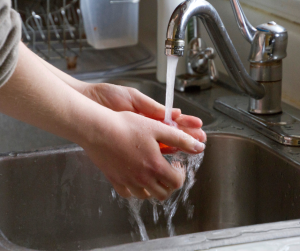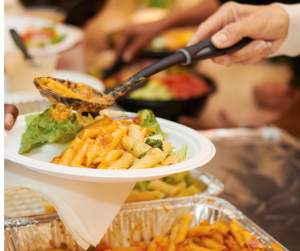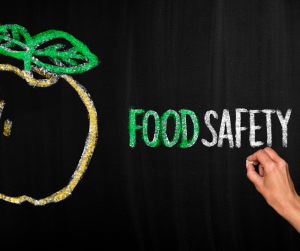Food safety matters to us all. Engaging in safe food handling procedures can prevent a serious food borne illness. CDC estimates 48 million people get sick, 128,000 are hospitalized, and 3,000 die from foodborne diseases each year in the United States. https://www.cdc.gov/foodborneburden/estimates-overview.html It is important to follow food safety guidelines to protect yourself, your family, co-workers, friends, and others.

The basic food safety principles are – clean, separate, cook and chill. https://www.cdc.gov/foodsafety/keep-food-safe.html

One of the basic food handling procedures is called the “2-hour rule”. Do you know what this is?

What is the 2-hour rule?
This is a common food safety practice. Hot foods need to stay hot. To keep hot foods safe, they need to be held at 140 degrees F or above. Cold foods need to stay cold. Cold foods must be kept at 40 degrees F or below.
Bacteria grow quickly between 40 degrees F and 140 degrees F. This is known as the danger zone. Discard all perishable foods such as meat, poultry, eggs, salads, and casseroles left at room temperature for longer than 2 hours. (including keeping foods in 1 hour in temperatures above 90 degrees F.)
This is important for cooking and serving food and storing leftovers.

Keep food out of the danger zone
What is the danger zone? Sounds scary! Bacteria can grow rapidly between the temperatures of 40° F and 140° F. After food is safely cooked, hot food must be kept hot at 140° F or warmer to prevent bacterial growth. Within 2 hours of cooking food or after it is removed from an appliance keeping it warm (like a Sterno), leftovers must be refrigerated. Discard all perishable foods that have been left at room temperature for more than 2 hours (or discard after 1 hour if the temperature is over 90° F, such as at an outdoor picnic during summer).

Cold perishable food(s), such as chicken salad or a platter of deli meats, should be kept at 40° F or below. When serving food at a buffet, keep food hot on the buffet table, in chafing dishes, slow cookers, and/or warming trays. Keep food cold by nesting dishes in bowls of ice or using small serving trays and replacing them often. Discard any cold leftovers that have been left out for more than 2 hours at room temperature (or after 1 hour when the temperature is above 90 °F). https://www.fsis.usda.gov/food-safety/safe-food-handling-and-preparation/food-safety-basics/leftovers-and-food-safety

When can food(s) get into the danger zone? What are some examples?
These would be events lasting longer than 2 hours where food is being served, but the hot food is not being kept hot and the cold foods are not kept cold.
- At a home birthday party celebrating family.
- A Thanksgiving feast.
- An office luncheon.
- At a family picnic held at a local park.
- At a festive holiday gathering where each guest brings a covered dish to share.
- At a meeting where potluck foods are being served.
- At a conference serving a catered meal for lunch.
- At a 4-H club meeting of youth members and volunteers.
- At the beach when grilling out on a hot summer day.
- At a church function serving food like a funeral.
- At a class reunion where classmates bring a potluck-covered side dish.
- A block party of neighbors gathering for some afternoon food and fun.
- Can you think of more examples?

Store leftovers properly and determine if they are safe to eat
The FoodKeeper app can help you determine if leftovers are safe to eat. You can download this app on your cell phone and have it handy when needed. https://www.foodsafety.gov/keep-food-safe/foodkeeper-app

Final thoughts
When we cook and serve food at home or eat out at another location, we need to be conscious of food safety and the basic food safety principles. The 2-hour rule helps us to do just that.
To ensure that food and leftovers are safe to eat, make sure the food is cooked to a safe internal temperature and refrigerate the leftovers promptly, which is before 2 hours. https://www.foodsafety.gov/food-safety-charts/safe-minimum-internal-temperatures Leaving food out at an unsafe temperature is a main cause of foodborne illness and may put the food in the danger zone. This could result in a costly foodborne illness and/or even death.
Safe handling of food is very important to reduce the risk of foodborne illness. Remember these recommendations for handling food safely at your next gathering. Don’t be afraid to speak up and get those leftovers safely into the refrigerator.
Do not forget what you have learned about the 2-hour rule when preparing food for your next event, and then putting that food out on a buffet table, kitchen countertop, picnic table, conference room table, etc.
Eat safe and healthy food. Food safety matters.

Resources to learn more about food safety and safe handling of food.
Leftovers and food safety – https://www.fsis.usda.gov/food-safety/safe-food-handling-and-preparation/food-safety-basics/leftovers-and-food-safety
Risks of eating raw oysters – https://blogs.ifas.ufl.edu/browardco/2022/08/26/eating-raw-oysters/
Prevent food waste – https://blogs.ifas.ufl.edu/browardco/2022/03/28/prevent-food-waste/
Engage in food safety behaviors – https://blogs.ifas.ufl.edu/browardco/2022/02/08/engaging-in-food-safety-behaviors-does-matter/
Keep food safety in mind at your Super Bowl party – https://blogs.ifas.ufl.edu/browardco/2021/02/04/keep-food-safety-in-mind-at-your-super-bowl-party/
Do not wash raw chicken – https://blogs.ifas.ufl.edu/browardco/2021/01/21/food-safety-tip-do-not-wash-raw-chicken/
Preventing the spread of germs and viruses – https://blogs.ifas.ufl.edu/browardco/2020/03/06/preventing-the-spread-of-germs-and-viruses-frequently-asked-questions/
What you need to know about foodborne illness and food safety – https://blogs.ifas.ufl.edu/browardco/2018/08/13/what-you-need-to-know-about-foodborne-illness-and-food-safety/
An equal opportunity institution.
 7
7
